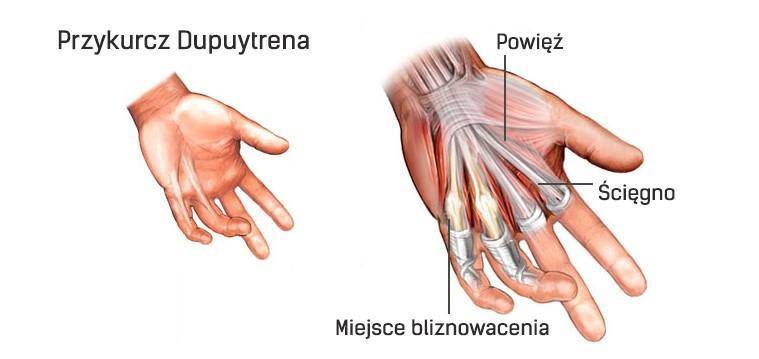Dupuytren's contracture
This is a flexion contracture of the fingers, which is much more common in men.
It most often affects the palmar surface of the hand. In about 25-60% of cases, it is genetically determined.
It is characterized by the appearance of a small bump or thickening in the palm area.

Causes:
Many factors contribute to the contracture, related to genetic complications and the coexistence of diseases of the nervous system (ulnar nerve, brachial plexus nerve roots, etc.).
The development of the disease is also influenced by repeated injuries and overloading of soft tissues, causing minor bleeds into the aponeurosis. They result in tissue fibrosis.
According to doctors, there is a correlation between the occurrence of contracture and alcoholism, diabetes and epilepsy.
Treatment:
Restoring the hand to function (or reducing the degree of contracture) is possible only as a result of the procedure. It is performed under local or general anesthesia. A tourniquet is used as anesthesia, causing the effect of ischemia of the operated limb.
The orthopedic surgeon cuts/cuts overgrown strands that cause contractions. The wound is closed with sutures and secured with a dressing (sometimes a plaster splint is used). If there is a need to drain the postoperative wound, a tube is inserted under the skin that drains the blood into a plastic bottle (the drain is removed the day after the procedure). Sutures and immobilization are removed after approx. 2 weeks. Convalescence lasts about a month.
Treatment complications:
- hematomas and swelling of the hands,
- skin necrosis around the postoperative wound,
- infections,
- limited mobility of the joints of the hands,
- chronic pain in the postoperative site,
- nerve damage
- recurrence of the disease (if it was operated on at a late stage).
Rehabilitation:
Hand exercises play a key role in returning to full fitness after surgery. They allow for tissue regeneration, scar reduction and regaining finger mobility. Rehabilitation can also be initiated at an early stage of contracture to prevent its further development.
contact
Address
-
- ORSMED
Przemysław Gliszczyński, Agnieszka Gemba spółka jawna
ul.Przemysłowa 3,
89-600 Chojnice
- ORSMED
Opening hours
-
- Mon - Fri: 9:00 AM - 6:00 PM
- Sat: 9:00 AM - 1:00 PM